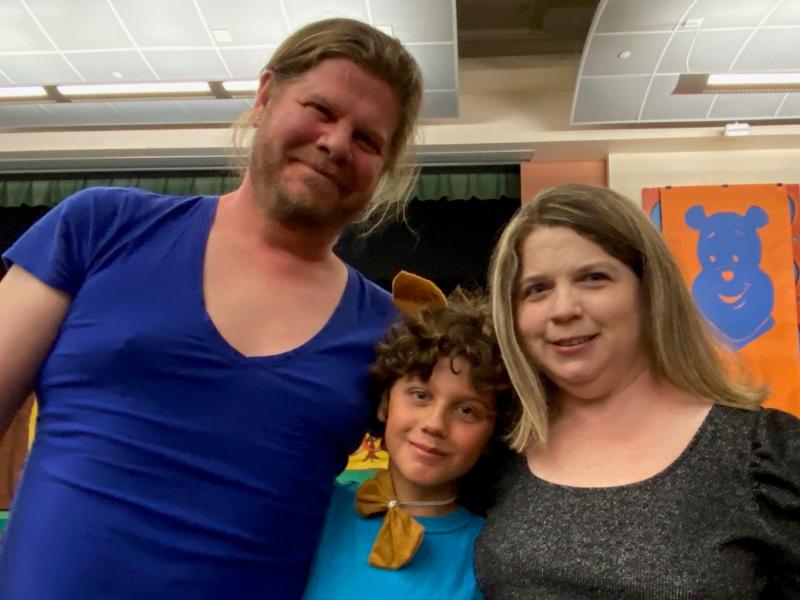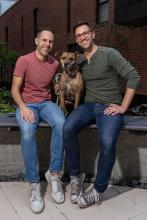The Artful Life Questionnaire: Katharine Hayward

NEA Accessibility Specialist Katharine Hayward (right), her husband Zack (left), and their son Joshua (middle). Photo by Katharine Hayward
What we know for sure: We all have a story, and engaging with the arts helps all of us to tell our own stories on our own terms. We also know that there are ways to engage with the arts other than in formal cultural venues, and that sometimes is more about the process of art making than it is about the end product. We also know that living an artful life, which is to say, living a life in which the arts and arts engagement are a priority means different things to different people based on their own interests, their communities, and many other factors, including equitable access. The Artful Life Questionnaire celebrates the diversity of ways we can make the arts a part of our lives, and, hopefully, inspires and encourages us to live our own unique versions of an artful life. In today’s edition of the questionnaire, we’re speaking with National Endowment for the Arts Accessibility Specialist Katharine Hayward.
NEA: Please introduce yourself.
KATHARINE HAYWARD: I am Katharine Hayward. I joined the NEA in March of this year as the Accessibility Specialist. In this role, I provide technical assistance and training on ways to engage members of the disability community in all aspects of the arts. I bring to this role over 20 years of experience in arts and accessibility and my own lived experience as a person with a disability. I have spent time in various parts of California, but have lived the majority of my adult life in the Bay Area. I am a proud mom of a pre-teen boy. Some people are dog or cat people, but I am a bunny person. I am never short on entertainment with my son and two bunnies around. I enjoy spending time with my husband and son, traveling when we can, but more often catching up on the latest Marvel show. At the end of a long day, I unwind by watching good, and sometimes, bad television.
NEA: Do you have a current art practice or a way of regularly engaging with the arts?
HAYWARD: I do not have an art practice, but I have been involved in choirs (university and community) on and off. I love dancing and use it as a form of exercise. It has been difficult to find a rhythm again since the pandemic, but I am working to bring it back into my life. Fortunately, music has re-entered my home through my son. He is learning to play the ukulele and is in rehearsals for the school musical, so many days I am running lines with him, singing songs, and attempting the latest choreography he has learned.
NEA: What are five words that come to mind when you think about the idea of living an artful life?
HAYWARD: Joy, expression, family, representation, and release.
NEA: Pick just one of those words and expand on how you see it as part of living an artful life.
HAYWARD: I want to expand on how representation is part of an artful life. I have had a long-time interest in how people with disabilities are portrayed in the media, including print, film, and television. Growing up, I rarely saw anyone that looked like me in television, film, or stage. And characters I read about were usually described in stereotypical or unidimensional ways, as the villain, the victim, or the uplifting hero who overcame their disability. These fictional representations of disability affected the way people saw and treated me, and that sometimes affected the way I saw myself. Art can be a powerful storyteller, and at its best you can see yourself in it. I am encouraged by the variety of storytelling I am beginning to see, especially when the stories are being told by people with disabilities themselves.
NEA: Where do you currently live, and what are some of the ways that your community tells its story through the arts or through creative expression?
HAYWARD: I live in San Jose, California, which is a very populous and expansive city comprised of multiple neighborhoods with a strong presence of Latinx and Vietnamese cultures. The diversity of communities brings great food, festivals, and celebrations. We are situated in Silicon Valley and the prevalence of the tech industry is evident throughout this area. In addition to several other museums, we have a museum, the Tech Museum of Innovation, dedicated to technology that includes many hands-on exhibits like designing and programming your own robot. The greater Bay Area (i.e., Oakland, Berkeley, and San Francisco) also has a rich arts and disability scene, home to one of the oldest physically integrated dance companies, an international disability film festival, and several other platforms to showcase the talent of artists with disabilities.
NEA: How do you think that living an artful life can improve the well-being of your community?
HAYWARD: I think art has the power to build community and connections. The early part of the pandemic was a strange time where I often felt very connected to my small family unit, but totally disconnected from the world. But there were also opportunities that had not existed before such as a virtual dance class I participated in weekly. I also reconnected with the choir I sang with prior to moving to San Jose. It was personally beneficial for me, providing an outlet for my anxiety, but it also created connections that I and others really needed during that time.
NEA: Is there a particular place in your neighborhood that is a creative touchstone for you?
HAYWARD: I walk, well, scooter around much of my community and have a chance to take in art that many others may miss. In walking around the neighborhood, I enjoy the colorful utility box murals that are every few blocks and large sculptures in front of the nearby hospital and college campuses. A frequent destination on walks is to our local library where I will often find a movie to borrow or become aware of community events.
NEA: What’s your favorite informal way or space to engage with arts and culture?
HAYWARD: Right now, the biggest way I experience art is in my home. Every room is filled with art pieces my husband and I have collected from various vacations, where we always make a point to visit the local artists’ collectives. We also have bookcases overflowing with everything from graphic novels to critical essays to mathematics textbooks. One of my favorite things that I do every night is read to my son before he goes to bed, like a live audio book that he falls asleep to. It has exposed me to some great youth fiction.
NEA: Can you share an arts experience or moment of arts engagement that has had an identifiable impact on your life?
HAYWARD: There is a moment of arts engagement that had a substantial impact on me, although I have only realized its importance as I have grown older. I was the first person who used a wheelchair to go to my high school and, subsequently, was the first wheelchair user to ever audition for the school musical. At the time, I never doubted that I would get in because I thought everybody got in. I knew that I could modify dance steps and could learn the songs, and the fact that the stage was inaccessible was just something to figure out. Thankfully, the director saw it that way too and was open to hearing what would work best for me. We found ways to make the choreography work for me and I had a dedicated space backstage where I could wait for my scenes rather than going up and down another set of stairs to the green room. The school also looked into equipment that made it easier for me to get on and off stage. I went on to perform in three musicals and continued to engage in the arts in other ways in college. Years later, I realized that this was a turning point, and that this was not what many people with disabilities experience when they strive to actively engage in the arts. I am grateful that I had a positive experience that strengthened my love of the arts and it showed me that you can find ways to engage everyone, including people with disabilities, in the arts if the willingness is there.





